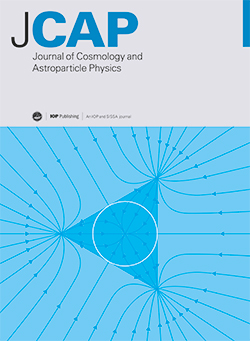避免脉冲星定时阵列在反弹环路校正 EFT 中产生的 SIGW 的 PBH 过度产生
IF 5.3
2区 物理与天体物理
Q1 ASTRONOMY & ASTROPHYSICS
Journal of Cosmology and Astroparticle Physics
Pub Date : 2024-09-03
DOI:10.1088/1475-7516/2024/09/013
引用次数: 0
摘要
为了揭示 PBH 过量产生问题的现状,我们的研究强调了非星状反弹有效场理论(EFT)框架内状态方程(EoS)参数 w 的关键作用。我们的分析集中在一个广泛的状态方程参数值范围内,这些参数值仍然是解释脉冲星定时阵列(PTA)最新数据的最佳参数。研究结果表明,在 PTA 信号的 SIGW 解释中,最有利的窗口(0.31 ≤ w ≤ 1/3)是大量 PBH 丰度(fPBH∈ (10-3,1))和大质量 PBH(MPBH ∼ 𝒪 (10-7-10-3)M⊙)的位置。当面对 PTA 时,我们发现避免生产过剩的情况介于 1σ-2σ 之间,而 EoS 参数位于 0.31 < w ≤ 1/3 的窄窗口内。我们提出了一个正则化-归一化-求和(RRR)标量功率谱,它足够大,可以在0.88≤cs≤1的范围内产生与PTA证据相容的依赖于EoS的标量产生的引力波,同时满足扰动性、因果性和单位性准则。本文章由计算机程序翻译,如有差异,请以英文原文为准。
Obviating PBH overproduction for SIGWs generated by pulsar timing arrays in loop corrected EFT of bounce
In order to unravel the present situation of the PBH overproduction problem, our study emphasizes the critical role played by the equation of state (EoS) parameter w within the framework of effective field theory (EFT) of non-singular bounce. Our analysis focuses on a wide range of EoS parameter values that are still optimal for explaining the latest data from the pulsar timing array (PTA). As a result of our study, the most advantageous window, 0.31 ≤ w ≤ 1/3, is identified as the location of a substantial PBH abundance, fPBH ∈ (10-3,1) with large mass PBHs, MPBH ∼ 𝒪 (10-7–10-3)M⊙, in the SIGW interpretation of the PTA signal. When confronted with PTA, we find that the overproduction avoiding circumstances are between 1σ-2σ, while the EoS parameter lies inside the narrow window, 0.31 < w ≤ 1/3. We propose a regularized-renormalized-resummed (RRR) scalar power spectrum that is large enough to produce EoS dependent scalar generated gravitational waves compatible with PTA evidence, while satisfying the perturbativity, causality, and unitarity criteria, within the range of 0.88 ≤ cs ≤ 1.
求助全文
通过发布文献求助,成功后即可免费获取论文全文。
去求助
来源期刊

Journal of Cosmology and Astroparticle Physics
地学天文-天文与天体物理
CiteScore
10.20
自引率
23.40%
发文量
632
审稿时长
1 months
期刊介绍:
Journal of Cosmology and Astroparticle Physics (JCAP) encompasses theoretical, observational and experimental areas as well as computation and simulation. The journal covers the latest developments in the theory of all fundamental interactions and their cosmological implications (e.g. M-theory and cosmology, brane cosmology). JCAP''s coverage also includes topics such as formation, dynamics and clustering of galaxies, pre-galactic star formation, x-ray astronomy, radio astronomy, gravitational lensing, active galactic nuclei, intergalactic and interstellar matter.
 求助内容:
求助内容: 应助结果提醒方式:
应助结果提醒方式:


